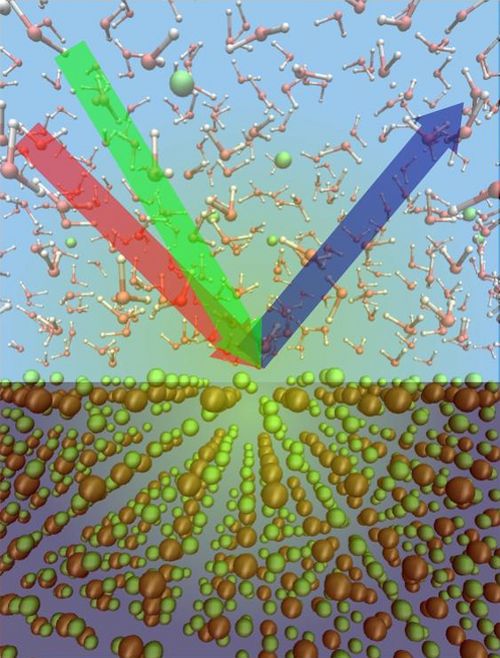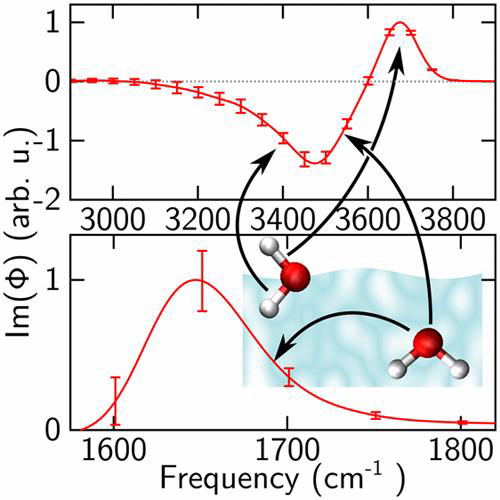MATERIALS SCIENCE AND CHEMISTRY
Unveiling Water Structure and Dynamics at Interfaces
Principal Investigator:
Marialore Sulpizi
Affiliation:
Johannes Gutenberg University, Mainz (Germany)
Local Project ID:
2DSFG
HPC Platform used:
Hazel Hen of HLRS
Date published:
The properties of water at interfaces such as liquid/vapor and liquid/solid interfaces are relevant to many fundamental processes in atmospheric chemistry as well as in biology such as protein folding and aggregation mechanisms. Leveraging HPC resources available at the HLRS, researchers at the Johannes Gutenberg University in Mainz apply ab initio molecular dynamics simulations (AIMD) in both equilibrium and non-equilibrium conditions, as AIMD simulations are an ideal tool for accurate descriptions of heterogeneous condensed phase systems. By simulating the behaviour of water at the nanoscale, the scientists aim for a better understanding about its properties at the interface.
Aqueous interfaces are ubiquitous in nature and in technology, however our knowledge of their fundamental physical chemistry is still very limited. Understanding the complex phenomena that take place at the solid/liquid interface can give us important clues on how to build better medical devices and more efficient energy converting technologies, with a profound impact for our society
The last few decades have seen tremendous progresses on both the experimental and the theoretical sides. On the experimental side, the advent of interface selective spectroscopy has permitted to obtain new information on the vibrational properties of water in confined environment and at the interface. We now know that water is not only bulk water, but that different types of water characterizes the “life fluid” at interface. The available experimental data call for a theoretical interpretation and for an atomistic picture which simulations can finally provide.
Interestingly, thanks to the supercomputing resource now available, the nanometer scale, characteristic of the interfacial phenomena, is within reach of simulations methods which also include an explicit treatment of electrons, while spectroscopic time-resolved techniques provide a meeting point between simulations and experiments in the (sub)picosecond time scale.
The research group lead by M. Sulpizi in Mainz is using HPC resources, in particular the Cray XC40 (Hazel Hen) installed at the HRLS, in order to simulate the behaviour of water at the nanoscale and to understand its properties at the interface.
The key questions the group is trying to answer are: how different are interfacial properties from those of the bulk? What are the consequences for the material in contact with water? How are the reactivity and the dynamics affected at the interface?
The group has pioneered the use of electronic structure based molecular dynamics simulations to calculate structure and vibrational properties of water at interfaces [1-6].
In particular, an expression for the calculation of the sum frequency generation spectra (SFG) of water interfaces has been developed, which is based on the projection of the atomic velocities on the local normal modes, and reduces the computational cost of the spectra calculations to that of the accumulation of a molecular dynamics trajectory [1,2].
This has permitted to investigate several water interfaces, including e.g. the water-vapor [1] and the fluorite-water interfaces at different pH conditions [2]. The results have been discussed in connection to recent phase resolved experimental data, permitting to shed new light on the microscopic structures of interfaces.
References:
[1] R. Khatib and . Sulpizi, J. Phys. Chem. Lett., 2017, DOI:10.1021/acs.jpclett.7b00207
[2] R. Khatib, E. H. G. Backus, M. Bonn, M.-J. Perez-Haro, M.-P. Gaigeot and M. Sulpizi Scie. Rep. 2016.
[3] M. Pfeiffer-Laplaud, M.-P. Gaigeot, and M. Sulpizi, J. Phys. Chem. Letters, 7 (16), 3229–3234, 2016.
[4] L. Salimi Parvaneh, D. Donadio, and M. Sulpizi J. Phys. Chem. C 120 (8), pp 4410–4417 016.
[5] M. Pfeiffer-Laplaud, D. Costa, F. Tielens, M.-P. Gaigeot, and M. Sulpizi J. Phys. Chem. C 119 (49), 27354–27362, 2015.
[6] T. Ohto, E.H.G. Backus, C.-S. Hsieh, M. Sulpizi, M. Bonn, Y. Nagata J. Phys. Chem. Lett. 6 (22), 4499–4503, 2015.
[7] K. Usui, J. Hunger, M. Sulpizi, T. Ohto, M. Bonn, Y. Nagata J. Phys. Chem. B 119 (33), 10597–10606, 2015.
Scientific Contact:
Marialore Sulpizi
KOMET 331
Institute of Physics
JGU Mainz, D-55099 Mainz (Germany)
email: sulpizi [at] uni-mainz.de
Website
April 2017

